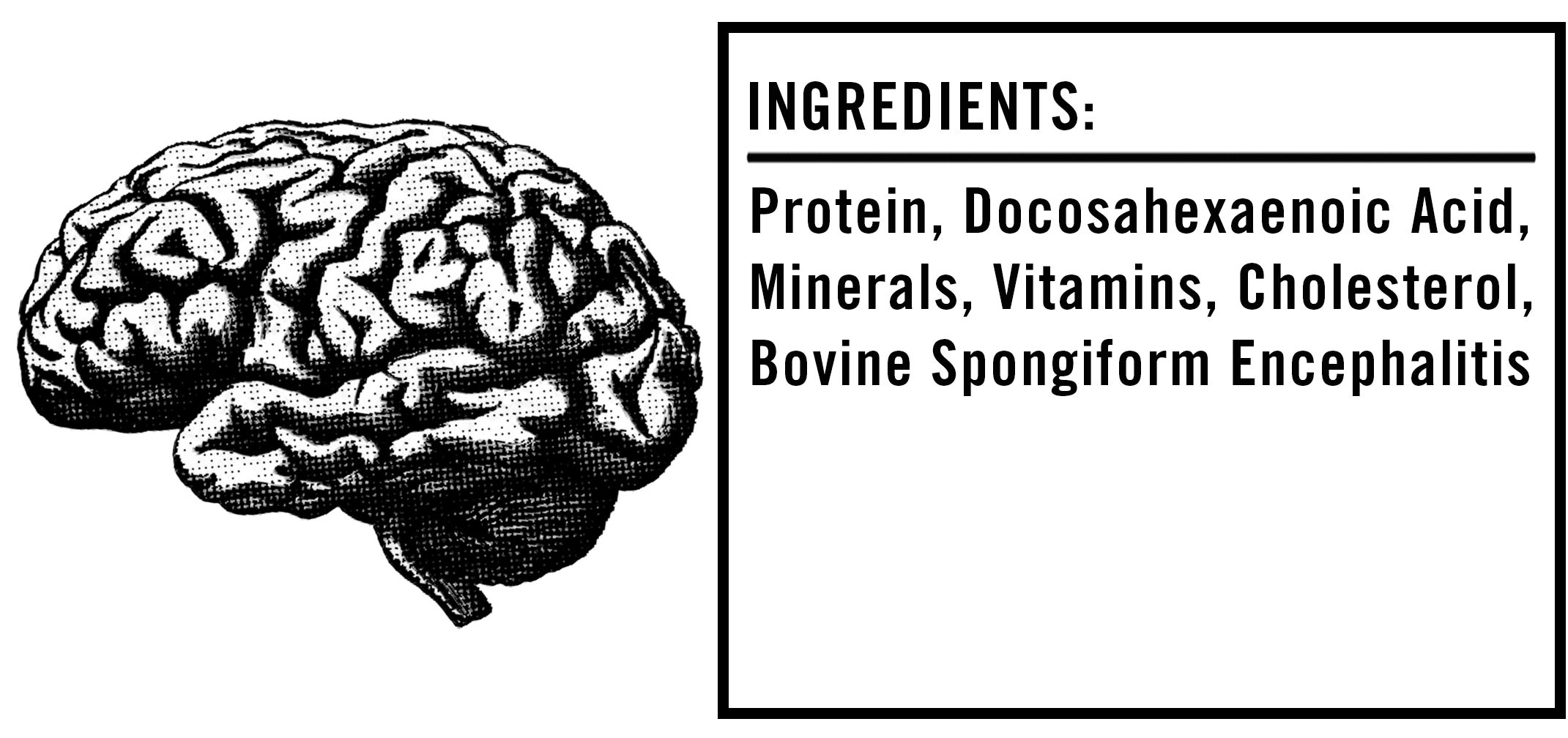We’re often told that you should never eat anything (or put anything on your body) if you don’t recognize everything on the ingredients list. But since most of us have no idea what xanthan gum or potassium benzoate are — or more importantly, what they’re doing to our bodies — we’re decoding the ingredients in the many things Americans put in (and on, or near) themselves.
In the name of Halloween, this week we’re devoting the column to exploring the only cuisine beloved by both dedicated gourmands and zombies: Organ meats. Since these are intrinsically single-ingredient foods, rather than analyzing the individual ingredients as we normally do, we’ll be examining them based on nutritional value and the like.
This edition: Beef brains, which have been picked apart based on nutritional value down below. Before probing some brains, though, despite the aversion many people have to consuming organ meats, know that humans have been sustained by them since the beginning — hunter-gatherers even prized organ meats more than other animal parts. The belief is that animals back then had much less meat on them — y’know, before we took to engineering them for the sake of eating — which meant organs were often the heartiest option, so to speak.
In more modern times, beef brains in particular are central to an assortment of beloved dishes around the world. Italians, for instance, nosh on fried beef brain morsels, which they lovingly call cervella fritte. Mexicans, meanwhile, regularly munch on tacos de sesos, or calf brain, usually braised and seasoned with chile sauce, then tossed into a tortilla. In the likes of Pakistan, Bangladesh and parts of India, maghaz, a brain-based curry, is incredibly popular. The list goes on.
Now, let’s take a look into some beef brains.

The Ingredients
1) Protein: Four ounces of beef brain boasts a decent 12.3 grams of protein.
*tosses Muscle Milk and takes bite out of cow’s head*
2) Docosahexaenoic Acid: Docosahexaenoic acid (DHA) is an important omega-3 fatty acid, most commonly found in seafood. However, four ounces of beef brain contains about one gram of DHA, or about the same as most standard portions of fish and the like. (Note that four ounces is one ounce more than the sensible, but laughably meager three-ounce recommended serving for all kinds of meat, seafood included, but that one extra ounce is also often cooked away, since the juices inside move to the surface during cooking and either linger in the bottom of the pan or evaporate).
As for what DHA does — all kinds of things, actually. On a more general level, omega-3 fatty acids reduce your risk of developing cardiovascular disease. DHA in particular, though, supports brain growth and function, especially during the early developmental stages. To that end, DHA can also help your brain stay sharp with age, and having too low a level of the substance in your body has been associated with cognitive diseases, like Alzheimer’s. DHA can also help preserve eye health, particularly in children. Finally, some research suggests that DHA can kill cancer cells.
3) Minerals: Beef brains are a notably high source of selenium and copper. Selenium works as an antioxidant, preventing free radical damage that could otherwise evolve into cancer. Copper, meanwhile, helps with energy production and maintains your immune system.
4) Vitamins: Vitamins B5 and B12 can be found in abundance in beef brains. Vitamin B5 supports your metabolism, helping convert food into energy. Vitamin B12, meanwhile, helps create DNA and keeps your nerve and blood cells healthy. It also prevents megaloblastic anemia, which makes people tired and weak.
5) Cholesterol: This is one of the potentially problem ingredients in beef brains, as just under four ounces — again, the standard, albeit sad, serving size of meat, which is equivalent in size to the palm of your hand or perhaps a deck of cards — contains a whopping 1,033 percent of the recommended daily intake for cholesterol. In general, brains are relatively fatty — in humans, the brain is the fattiest organ in the body — and since cholesterol is a fatty substance found in blood, which is constantly flowing to the brain, it makes sense why beef brains are so high in cholesterol.
Now, cholesterol is a complex and disruptive subject among nutritionists, however. Many hold that too much of the stuff, especially in people sensitive to dietary cholesterol, is a major risk factor in the development of heart disease. And, y’know, 1,033 percent of the daily recommended amount certainly sounds like too much.
6) Bovine Spongiform Encephalitis: To be clear, bovine spongiform encephalitis is an irregular and extremely uncommon ingredient in beef brains. But it can show up in them, and when it does, the consequences could be deadly. Eating beef brains infected with bovine spongiform encephalitis — also known as Mad Cow Disease — can result in the development of Creutzfeldt-Jakob disease, a deadly neurodegenerative disorder that essentially eats away at your brain until you die. There are currently no cures, either.
Fortunately, this disease is extremely rare — it occurs at a rate of two in every one million people throughout the world — and the USDA requires that all brain and spinal cord materials be removed from high-risk cattle, like those unable to walk or showing signs of neurological problems. In other words, these cow products should theoretically never enter the U.S. food supply. But watch out for that back-alley beef brain.
The Takeaway
Overall, beef brain is a pretty healthy food if you can get over the whole mushy, brainy aspect. There are some concerns — namely, the high amounts of cholesterol and the whole death-from-a-degenerative-brain-disorder thing — but so long as you keep your brain-eating to a minimum, which I imagine you will, you should be just fine. Bone apple tea!

